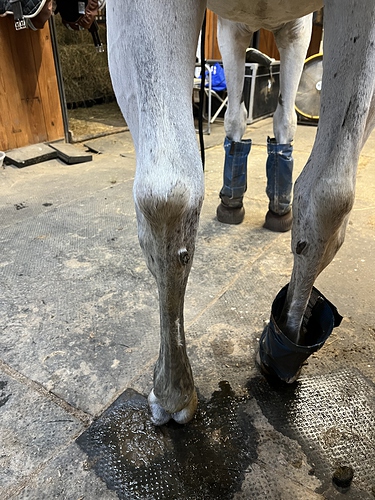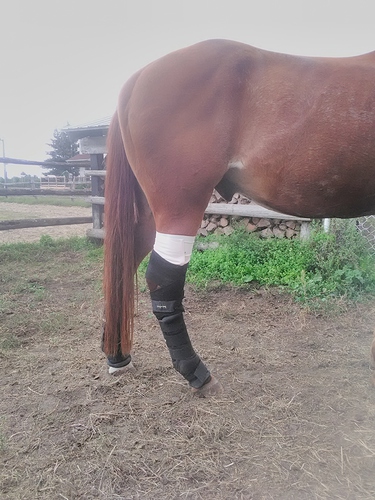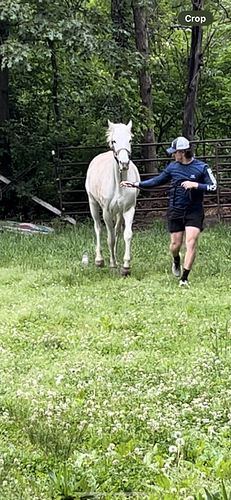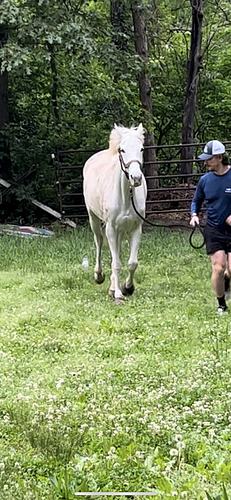My mare came in from turnout on Wednesday with a fever, ataxia, lethargy, and lameness. Her LH quickly ballooned over the following hours and vet has determined it to be a case of cellulitis. We started her on bamamine (which I ran out of and she is now on bute 2g twice a day) and SMZs with a sweat wrap (DMSO and Furacin) and cold hosing every 12 hours. The fever and lethargy resolved quickly, but the lameness and ataxia remain. I’ve managed to get the fluid mostly out of her cannon area (where the sweat wrap sits) but her hock is looking worse. She is being turned out with her buddy in a small paddock. They mostly stand and munch (both are older and not playful), both vet and I wanted her to move as much as she’s comfortable with to help with the fluid. What can I do to get the swelling down in her hock?
That’s not bad at all, it looks really good! Movement and time will resolve this. Can you hand walk her if she’s not very active in turnout?
Definitely! I may put them on a slightly larger grass area for a few hours today, thinking they will walk around a bit more to graze.
Her hock is looking like it’s turning into a capped hock situation. It’s not firm-swollen like the rest of the leg is/ was, but a bit squishy (water pressure from hose makes a dimple). Normal?
Yep, normal as far as I’ve seen. It takes awhile for the lymph system to return to normal. I wouldn’t worry! 
Wow I have had way more experience with horses with cellulitis than I ever wanted to but have never had any with ataxia. That would scare the crap out of me. Has your vet explained that symptom’s etiology?
agree. Ataxia is neuro
This is what I did the first time my horse got cellulitis from a 1/4" nick 3-4" below his stifle. There’s a Back on Track quick wrap on his cannon, a white 6" wide elastic wrap around his gaskin, and a Back on Track polo wrap over his hock.
This infection prompted an “I think your horse has a broken leg” call from my BO because my horse was not bearing any weight on it and refused to move. 
Vet is caring for horse “remotely” (aka via texts, photos, videos) as she isn’t able to fit in an emergency visit/ doesn’t think this is needs an emergency visit. I have been pushing for an answer on the ataxia portion but her response has been that it’s likely due to the inflammation + fever (which is now gone). I don’t agree.
I don’t have much cellulitis experience (maybe 1-2 other times in 14 years?), but am fairly certain the ataxia should not be correlated with the cellulitis. Maybe it isn’t true ataxia and I’m blowing it out of proportion (though I’ve spent years watching this horse for lameness so am pretty adept at watching her gait for anomalies).
She picks the leg up and puts it down almost like she doesn’t know where it’s at, and is moving on three tracks (LH following RF, RH out in space on its own same with LF). She got spooked by the neighbors while in TO today and cantered around on 3 legs, holding the LH up, which I’ve never seen her do with any of her injuries/ lamenesses/ issues. She did walk on it okay after the fact, and was fine to rest the opposite hind and bear weight on it.
We are limited in the other vets I can call out on emergency. I have one that always comes, but is incredibly limited in their diagnostics (no digital X-rays, no ultrasound, etc). Nearly all vets, save the aforementioned “old” style vet and my vet, do not do farm calls anymore and I currently don’t have a trailer (plus this horse has a history of balance issues in the trailer on a good day, I don’t want to trailer her if she’s having ataxia issues on top of that).
ETA photos where you can see her on 3, nearly 4, tracks when jogging in hand:
I’d also be more worried about the ataxia. Could your horse have Lyme disease?
My previous horse had Lyme disease several (more than three) times. Cellulitis twice accompanied the Lyme disease. My mare didn’t have ataxia, but Lyme disease can cause neuro symptoms.
I’d ask your vet about Lyme and possibly start your horse on some doxycycline until you can get the horse tested.
Good luck.
Lyme is supposedly not common here in the Midwest (I say supposedly as we have plenty of ticks - had one on me today). I will see about Lyme as well! The sudden onset is incredibly concerning.
Whether that is ataxia or not is not something I can judge from your description or photos but if it is ataxia it is not from cellulitis unless the infection somehow crossed over the brain barrier. In that case I think she would appear to be extremely ill. I understand your predicament about lack of vet care but if she were mine I would find a way to get her actually seen by a vet for a neuro exam. You can trailer her loose and just drive very slowly and carefully and hope for the best. I think that is a risk you have to take to get her medical care if you can’t get care to come to her. Best of luck to you both
Is there any chance she’s on Trazadone? It’s been documented to produce symptoms of ataxia; I’ve actually seen a horse on Trazadone look exactly like you are describing. It came on quickly and scared the socks off of me. I called the vet immediately who reassured me. I hope this is helpful somehow.
You need to wrap both areas. It’s called a stack wrap. Wrap the cannon first, then wrap the hock using a separate wrap on top. The bottom wrap essentially holds up the top hock wrap. Keep sweating. For cellulitis I prefer Exceed antibiotic (1 injection, followed by another 4 days later) instead of SMZs.
When I was dealing with cellulitis, after the swelling was going down, I’d use the Back on Track quick wraps for a couple of hours a day. I think they were helpful in re-establishing good circulation in the areas affected.
I have unfortunately a lot of experience wrapping both front and hind legs for cellulitis. What I found works best for the hock is to standing wrap the cannon bone, then get cotton batting and wrap the hock 2-3 times around with the batting, cutting a slit for the point of the hock. Wrap with a flannel over the batting leaving the point of the hock unwrapped and have some masking tape in case the velcro doesn’t reach. Occasionally I’d use elastikon around the top of the wrap to keep it from slipping down. I could usually get several days of wrapping out of the piece of cotton batting if I used saran or paper between the sweat and the cotton batting.
Wrapping a hock isn’t that hard. You “stack” it - i.e. put a standing wrap on the lower leg first. What you do for the hock will depend on how competent you are with bandaging. Easiest option would be a back on track hock wrap. If you need compression, there are two different types of bandage that work - Figure 8 and Spider. Youtube should produce examples of how to do both. There also used to be copies of the Pony Club guide to bandaging online, which has step by step pictures.
That said, I wouldn’t even bother with the level of swelling you have. Lots of hand walking, turnout, and time will fix that.
I would, however, want a full neuro exam and bloodwork for EPM and Lyme asap. From the sounds of it, (horse is unstable in trailer), you may have a longer standing neuro issue?
We had a horse at my barn with severe cellulitis. You could see how painful it was as horse didn’t want to walk and when he did, he kinda swung his leg along and staggered because fetlock & hock was so swollen. Even gently cold hosing it several times a day for the first 3 days made him shake with pain. I could see why you might describe your horse’s movement as ataxic, but it may just be his way to deal. Our horse had a fever and didn’t want to eat in the beginning, but he would graze and shuffle on the summer grass. When the fever went down he went back to normal eating. Movement is the best thing after meds and icing/cold hosing to reduce swelling. I’ve seen legs weeping serum and eventually split open due to swelling, so OP’s doesn’t look like a worse case scenario. But some horses are drama queens when it comes to a painful condition like cellulitis.




